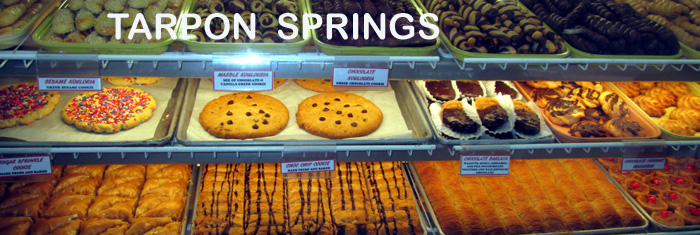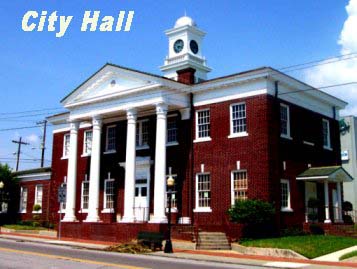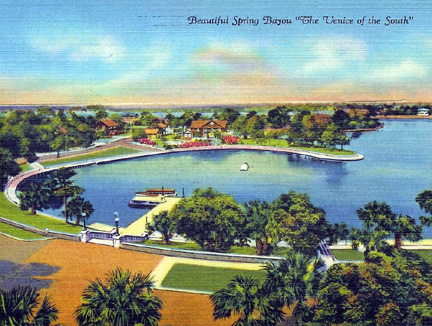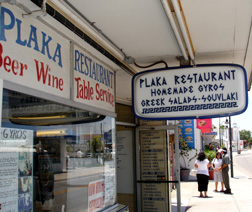

Tarpon
Springs has long been known as the
"Sponge Capital of the
There is another Tarpon Springs - actually the original one. When you visit Tarpon Springs, you get two towns for the same visit. The city
first developed in the 1880's under Hamilton Disston
as a winter resort for wealthy Northerners. They came down on Peter Demens' railroad and many built large mansions along the main bayous. Tarpon Springs has preserved the charm of its downtown area by converting many old shops to antique shops, niche firms, and restaurants. You should park downtown and stroll the historic downtown and either walk or drive down the hill to the springs and see the mansions.

WHERE TO START: Turn west off
(1) L. D. VINSON FUNERAL HOME (1911), 456 Tarpon Avenue, a
two-story masonry structure once the home of Levin Dent Vinson, who opened the
community's first general store in 1880. Across the street is the: (2) CRETEKOS
HOUSE (1916),
The last three houses on the block on the
left are more typical of early non-Greek residences, including the second from
the end, the large: (3) DR. JAMES A. DOUGLAS HOUSE (1905), 406
Tarpon Avenue, a frame house with a fine gable roof. At 427 East Tarpon Avenue is the BLUE BAYOU INN, a 1905 Craftsman and typical of the many little bed and breakfast spots around Tarpon Springs.
CROSS GROSSE. The last house on the right was once the: (4) OLD
BAPTIST CHURCH (1905), At the end of the block on the left is the
former: (7) LEOUSIS SALOON (1905), TURN LEFT (south) on
CROSS RING, entering the commercial blocks. You may wish to PARK IF YOU WANT TO
STROLL THE DOWNTOWN SHOPPING DISTRICT.
The last three stores on the left include the: (5) BOYER CHEVROLET SHOP
(1910),
 >
>
Across the street is the: (8) D. A.
ALISSANDRATOS BUILDING (1909), 201 Tarpon Avenue, a one-story bank
structure started as United Divers, a supply house for divers.
 On your right is the: (10) OLD DRY GOODS STORE
(1912), 163 Tarpon Avenue, a restored two-story masonry building with a
rounded southeast corner. Drivers will find it difficult to see every structure
without a second trip so I'll describe this downtown block by each side.
On your right is the: (10) OLD DRY GOODS STORE
(1912), 163 Tarpon Avenue, a restored two-story masonry building with a
rounded southeast corner. Drivers will find it difficult to see every structure
without a second trip so I'll describe this downtown block by each side.
On your right next to the Dr Goods Store is the (11) W. H. GOURLEY HARDWARE
(1905),
The first downtown building up after a disastrous fire in 1894 is the (14) G.
W. FERNALD BUILDING (1894), 121 Tarpon Avenue, a general store
designed by New Orleans architect Willis Castaing.
Next door at
 The right side of the block contains, after the
railroad station, the (17)
The right side of the block contains, after the
railroad station, the (17)
Next door is the (21) ERNEST MERES BUILDING (1914), 100 Tarpon
Avenue, built by Tampa architect M. Leo Elliott as the Hotel Meres and Royal Theater where Will Rogers once performed.
PASS HIBISCUS where on your right is the (22) A. L. ELLIS DRUG STORE (1913),
 On your right is the massive facade of the: (24) ARCADE
HOTEL (1924), 200 S. Pinellas Avenue, once part of a Spanish mission
style Boom Time hotel, converted into an arcaded mall.
On your right is the massive facade of the: (24) ARCADE
HOTEL (1924), 200 S. Pinellas Avenue, once part of a Spanish mission
style Boom Time hotel, converted into an arcaded mall.
TURN RIGHT ON BOVER and then
 Drivers should TURN RIGHT ON SPRING BAYOU. On your
right is the unlikely named: (25) REVEREND MILES STANDISH HOUSE (1912),
a double varanda facaded
house of unsapped pine. Next door is the unusual:
(26) THE CRESCENT PLACE (1886), 115 South Spring, a V-shaped
Queen Anne mansion designed by hardware manufacturer Edward Newton Knapp to fit
his curved lot. President of the Tarpon Springs Yacht Club, Knapp allowed no
square rooms in the estate.
Drivers should TURN RIGHT ON SPRING BAYOU. On your
right is the unlikely named: (25) REVEREND MILES STANDISH HOUSE (1912),
a double varanda facaded
house of unsapped pine. Next door is the unusual:
(26) THE CRESCENT PLACE (1886), 115 South Spring, a V-shaped
Queen Anne mansion designed by hardware manufacturer Edward Newton Knapp to fit
his curved lot. President of the Tarpon Springs Yacht Club, Knapp allowed no
square rooms in the estate.
TURN
Next door is the: (28) JOHN K. CHENEY HOUSE (1890), 30 West Tarpon,
home for the
 TURN LEFT (north) on PINELLAS AVENUE (US19A) and PARK
near the: (29) ST. NICHOLAS GREEK ORTHODOX CATHEDRAL (1943),
36 Pinellas Avenue, site of the largest Epiphany ritual in the United States
and a much cherished Byzantine Revival edifice copying St. Sophia in
Constantinople. If the church is open, you should see the 23 unique stained
glass windows and the three massive Czech chandeliers. The sixty tons of Greek
marble once graced the Greek exhibit at the first
TURN LEFT (north) on PINELLAS AVENUE (US19A) and PARK
near the: (29) ST. NICHOLAS GREEK ORTHODOX CATHEDRAL (1943),
36 Pinellas Avenue, site of the largest Epiphany ritual in the United States
and a much cherished Byzantine Revival edifice copying St. Sophia in
Constantinople. If the church is open, you should see the 23 unique stained
glass windows and the three massive Czech chandeliers. The sixty tons of Greek
marble once graced the Greek exhibit at the first
TURN LEFT down
CONTINUE RIGHT ALONG SPRING BAYOU. The big mansion on your right is the: (31) GEORGE
CLEMSON ESTATE 1902) 110 North Spring, the most magnificant
shingle house on the West Coast, built by a
At 144 North Spring is the (33) MARSHALL ATWORTH HOUSE (1895),
the timber baron who discovered the
On the curve is the Greek Revival
house with Ionic columns known simple as the (35) TSAVARIS HOUSE (1889).
At 166 North Spring is the (36) MARY BIGELOW HOUSE (1885), best
known as the residence of the mother of the owner of the last house on the
block, the (37) HAYES BIGELOW COTTAGE (1899), a T-plan bungalow
moved here by famous nature photographer Hayes Bigelow whose pictures of the early
Bayou are famous.
TURN
RIGHT ON READ STREET. The last house on the right is the: (38) REV. HENRY
DE LAYAYETTE WEBSTER (1885) 101 Read Street, founder of the local
TURN RIGHT ON GRAND BOULEVARD and stop at the: (39)
UNIVERSALIST CHURCH
(1907), 57 Read Street, a one-story masonry edifice with a castellated
tower, visited for its six wonderful landscape panels by George Inness Jr.
Before leaving the area, walk up nearby Parkin Court
to view the historic: (40) ANSON P. K. SAFFORD HOUSE (1883),
23 Parkin Court, home of the founder of Tarpon
Springs, an Arizona Territorial Governor and friend to land developer Hamilton Disston. The house was moved off the Bayou in 1981 and used
as a boardinghouse .
VISITING THE GREEK SPONGE DOCKS: One may reach the popular Greek
shopping and restaurant district by the Anchote River
by driving up Read and turning LEFT ON PINELLAS AVENUE (US19A) or by driving
NORTH ON GRAND TO HOPE STREET, a backyard look at and area where Greek divers
lived since 1905 when New York sponge exporter John Cocoris
recruited divers from the Dodecanese Islands. In 2014 the Greektown Historic District became a National Register of Historic Places site. The area north from Spring Bayou to the Anclote River has cute cottages and small shops where the original Greek population lived. Recent generations of local Greeks have moved into land-based occupations and every professional field.
Along the route is the (41) NAT STONE
APTTEN HOUSE (1884), two-story frame residence of an area pioneer
farmer, and the (42) JOHN SAMARKOS HOUSE (1915), founder of the Samarkos Sponge Company.
 You will enter commercial
You will enter commercial
WHERE TO DINE: There are a lot of choices along the Dodecanese Avenue. HELLAS RESTAURANT and BAKERY (727-943-2400), at 785 Dodecanese, has great food, lots of tables, and a bakery where even if you don't dine here, you will want some pastries and baklava. My Greek friends vouch for MYKONOS (727-934-4306) , 628 Dodecanee. But if you prefer seafood and a dockside view of the river traffic, you can not beat RUSTY BELLIES WATERFRONT GRILL (727-934-4306) at 937 Dodecanese at the far turn. You might not take a two-hour bayou cruise or purchase a sponge (not a local product today), but I wager you will want to dine at a restaurant.